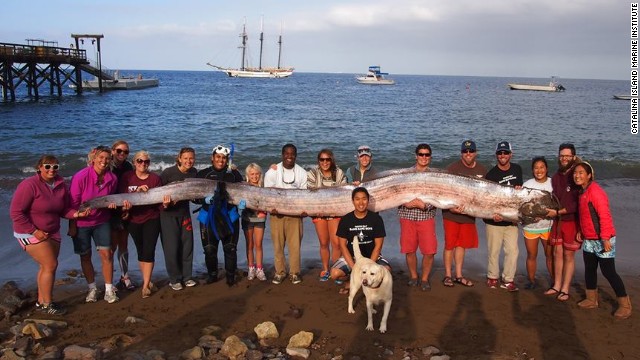
A marine science instructor's late-afternoon snorkel off the Southern California coast last Sunday was first met with shock and soon excitement when she discovered a gigantic oarfish, a deep-sea creature that remains little known to the science world and people outside.
Jasmine Santana was about 15 feet underwater when she found the 18-foot-long, silvery fish with reddish fins and eyes the size of a half-dollar staring at her from the sandy bottom. Realizing it was dead, she snatched the fish's tail, and using buoyancy and low tides, powered her way back on shore.
"I was first a little scared," said the still-thrilled Santana, who has been working for Catalina Island Marine Institute since January. "But when I realized it was an oarfish, I knew it was harmless."
After a 15-minute swim dragging the 400-pound carcass, she needed help from 14 others to lift the fish out of the water at Toyon Bay, California.
"I was really amazed. It was like seeing something in a dream," said Mark Waddington, the senior captain of CIMI's sailing school vessel the "Tole Mour" who gave Santana a hand. "It's the first time I ever witnessed an oarfish this big."
"Oarfish are found in all temperate to tropical waters, but are rarely seen, dead or alive," CIMI, a non-profit marine science education group, said in a release. "It is believed that oarfish dive over 3,000 feet deep, which leaves them largely unstudied. and little is known about their behavior or population."
Waddington, who has been with CIMI since 1994, said it remains unclear why the oarfish was found in shallow water this time, but it appeared to have died naturally.
Waddington said while the oarfish's carcass is still being preserved in ice, CIMI has been sending some of its tissues and other samples to marine scientists, including Dr. Milton Love, a fish expert from University of California at Santa Barbara, to study its DNA and diet habits.
Waddington said CIMI will likely to keep the fish's skeleton for educational purposes. Its program attracts more than 30,000 school-age children each year.
CNN.COM
Former President George W. Bush's heart situation that caused him to undergo a procedure in August was more serious than originally thought, as two sources close to the 43rd president now confirm he had a 95% blockage in an artery.
Bush, 67, had a stent placed in his heart in August at a Dallas hospital one day after the blockagWhile a 95% blockage is significant, Bush's doctors are not commenting about how grave the situation may or may not have been.
National Journal first reported the level of the blockage, but one source close to Bush downplayed any reports of a near-death experience. Another source said "it was very serious."
The rate at which a vessel becomes blocked is more important than the overall blockage, and the heart can do a good job of compensating, if it has time.e was discovered.
"Certainly President Bush was at significant risk having a 95% blockage in one of his coronary arteries. That doesn't mean he was going to have a heart attack," Warren Levy, a cardiologist, told CNN. "But certainly he was at significant risk for a heart attack and something did need to be done."
Marc Siegel, a physician and medical director of Doctor Radio at NYU Langone Medical Center, penned a column for USA Today in August praising the doctors' fast work on Bush's heart.
"Bush's stress test showed EKG changes, and what happened next was also prudent. A CT angiogram revealed a severe blockage in a crucial position in a coronary artery that was easily life threatening," he wrote.
Bush said last month at a golf tournament for other wounded veterans that he's "doing fine."
"Other than the fact that I nearly bled to death when I nicked myself shaving because I'm taking blood thinner, I'm doing pretty good," he joked in an interview with ABC's "Good Morning America." "I thought you were going to have to put a tourniquet on me."
Over Memorial Day weekend, Bush led another group of wounded warriors on an annual long distance bike ride at his ranch in Crawford, Texas.
The 43rd president was known for having good health during his tenure at the White House. For exercise, he was an active runner and frequently rode his mountain bike.
No comments:
Post a Comment